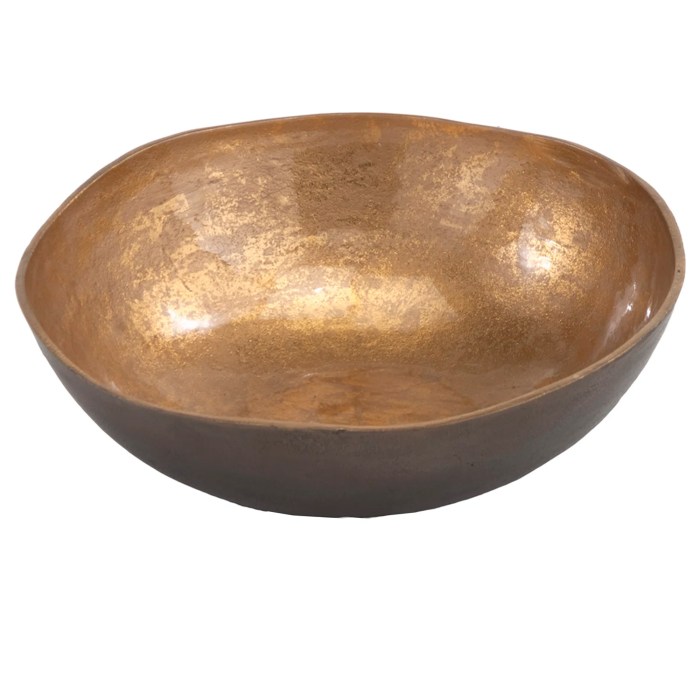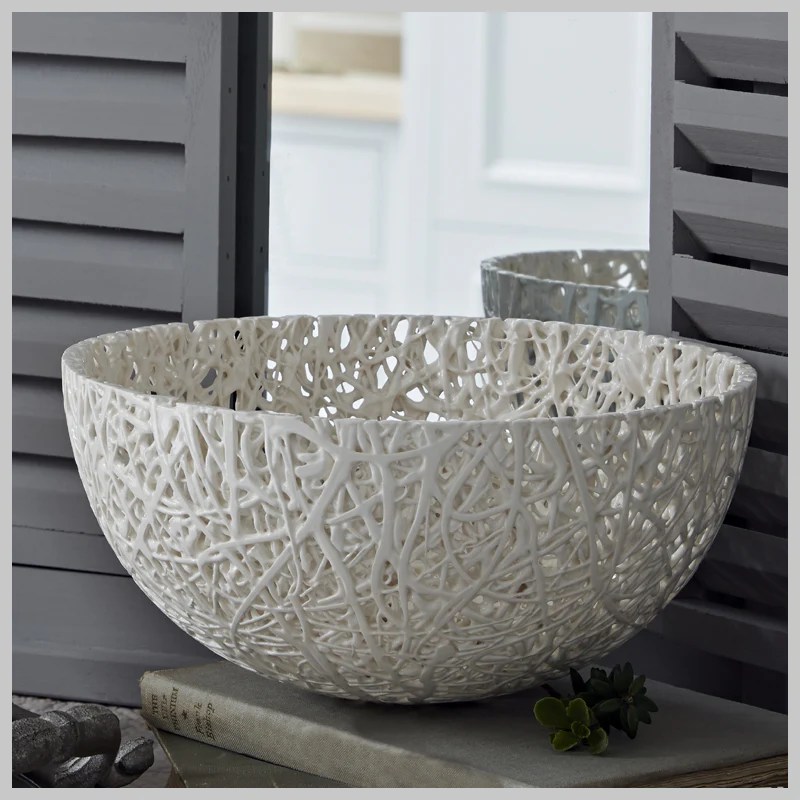Large Decorative Bowls: More than mere vessels, they are statement pieces, transforming spaces with their artistry and presence. From sleek minimalist designs to rustic, handcrafted wonders, the world of large decorative bowls offers a captivating spectrum of styles, materials, and uses. This guide delves into the diverse world of these captivating home accents, exploring their design elements, placement in interior design, and the care needed to preserve their beauty.
We’ll examine the various materials used—ceramic, glass, metal, wood, and resin—comparing their durability, maintenance needs, and aesthetic qualities. We’ll also explore different design styles, from modern and minimalist to bohemian and traditional, and discuss how to choose the perfect bowl to complement your existing décor. Finally, we’ll provide practical advice on cleaning, care, and storage to ensure your large decorative bowl remains a cherished part of your home for years to come.
Design Elements and Styles

Large decorative bowls transcend mere functionality; they are statement pieces, adding character and visual interest to any space. Their aesthetic appeal stems from a careful interplay of design elements and stylistic choices, creating a diverse range of options to suit various tastes and interior designs. Understanding these elements is key to appreciating the artistry and craftsmanship involved in creating these captivating objects.
Color, Pattern, and Texture in Large Decorative Bowls
Color significantly impacts the overall mood and feel of a decorative bowl. A vibrant, saturated color like cobalt blue can evoke a sense of energy and luxury, while a muted tone, such as sage green, might convey calmness and serenity. Patterns, whether geometric, floral, or abstract, add visual complexity and can create focal points. For instance, a bowl featuring a bold geometric pattern could be a modern centerpiece, whereas a bowl with intricate floral designs might complement a more traditional setting.
Texture plays a crucial role in tactile appeal and visual interest. A smooth, polished surface can create a sense of elegance, while a rough, textured surface might evoke a rustic or handcrafted feel. Imagine a sleek, black ceramic bowl with a high-gloss finish contrasted against a rustic, hand-thrown terracotta bowl with a visibly uneven surface – each offers a distinctly different aesthetic experience.
Design Styles in Large Decorative Bowls
Several distinct design styles influence the creation of large decorative bowls. Minimalist bowls often feature clean lines, simple shapes, and a neutral color palette, emphasizing functionality and understated elegance. A minimalist bowl might be a simple, white ceramic sphere, devoid of ornamentation. Bohemian bowls, in contrast, are characterized by vibrant colors, eclectic patterns, and often incorporate natural materials like wood or rattan.
Visualize a large bowl with a mix of bright colors, intricate embroidery, and tassels, reflecting a free-spirited and layered aesthetic. Rustic bowls emphasize natural materials and textures, often showcasing imperfections and handcrafted details. These bowls might be made of rough-hewn wood or terracotta, displaying a sense of warmth and earthiness. Modern bowls prioritize clean lines, geometric shapes, and innovative materials.
Think of a large bowl made of sleek, polished metal with a geometric pattern, exuding a sense of contemporary sophistication. Traditional bowls often draw inspiration from historical styles and techniques, incorporating intricate details, ornate patterns, and classic color palettes. A large, hand-painted porcelain bowl with a detailed floral pattern could exemplify this style.
Current Design Trends in Large Decorative Bowls
The landscape of decorative bowl design is constantly evolving. Several trends currently shape the creation of these pieces:
- Sustainable and Eco-Friendly Materials: A growing emphasis on sustainability is leading to the use of recycled materials, reclaimed wood, and ethically sourced resources in bowl production. Examples include bowls made from recycled glass or sustainably harvested bamboo.
- Biophilic Design: Incorporating natural elements and textures into designs, mirroring nature’s forms and patterns. This includes bowls with organic shapes and natural color palettes.
- Maximalist Aesthetics: A reaction against minimalism, favoring bold colors, intricate patterns, and layered textures. Think richly colored bowls with elaborate embellishments.
- Artisan Craftsmanship: A renewed appreciation for handcrafted items, leading to an increase in the popularity of uniquely designed, one-of-a-kind bowls.
- Geometric and Abstract Patterns: Clean lines and abstract forms continue to be popular, creating visually striking and modern pieces.
Care and Maintenance of Large Decorative Bowls

Large decorative bowls, statement pieces in any home, require careful handling and regular maintenance to preserve their beauty and longevity. The material from which the bowl is crafted significantly impacts its care requirements. Understanding these nuances ensures your bowl remains a cherished item for years to come. This section details proper cleaning methods, addresses common problems, and offers storage tips for various bowl materials.
Cleaning Methods for Different Materials
The cleaning method for your large decorative bowl depends entirely on its material composition. Improper cleaning can damage delicate surfaces or leave unsightly residue. Therefore, always identify the material before attempting any cleaning.
- Ceramic Bowls: Generally, ceramic bowls can be cleaned with warm, soapy water and a soft sponge. Avoid abrasive cleaners or scouring pads, which can scratch the surface. For stubborn stains, a mild solution of baking soda and water can be effective. Rinse thoroughly and dry completely to prevent water spots.
- Glass Bowls: Glass bowls are relatively easy to clean. Warm, soapy water and a soft cloth or sponge are usually sufficient. Avoid harsh chemicals that can etch the glass. For particularly difficult stains, a vinegar and water solution may be helpful. Again, thorough rinsing and drying are crucial.
- Metal Bowls: Metal bowls, depending on the type of metal (e.g., brass, copper, silver, stainless steel), may require specialized cleaning methods. Brass and copper bowls often benefit from polishing with a dedicated metal polish to maintain their shine. Silver bowls may require polishing cloths or silver cleaning solutions to prevent tarnish. Stainless steel bowls can usually be cleaned with warm, soapy water.
Common Problems and Solutions
Several issues can affect the appearance and structural integrity of large decorative bowls. Proactive measures and timely intervention can mitigate these problems.
- Chipping and Cracking: Dropping or bumping a large bowl can lead to chipping or cracking. Handle bowls carefully and avoid placing them in areas prone to accidental impacts. Minor chips on ceramic bowls can sometimes be repaired with specialized ceramic repair kits. Significant damage often requires professional repair or replacement.
- Tarnishing (Metal Bowls): Metal bowls, especially those made of brass, copper, or silver, are susceptible to tarnishing due to oxidation. Regular polishing with appropriate cleaning solutions helps prevent and remove tarnish. Storing metal bowls in a dry, airtight container can also minimize tarnish.
- Discoloration (Ceramic and Glass Bowls): Certain stains can cause discoloration on ceramic and glass bowls. Prompt cleaning is essential to prevent staining from becoming permanent. For stubborn stains, consult specialized cleaning guides for your specific bowl material.
Storage and Protection, Large Decorative Bowl
Proper storage is crucial for maintaining the condition of large decorative bowls.
- Padding and Protection: Wrap delicate bowls in soft cloths or bubble wrap before storing them to prevent scratches and chipping. For particularly valuable pieces, consider using acid-free tissue paper.
- Storage Location: Store bowls in a cool, dry place, away from direct sunlight and extreme temperature fluctuations. Avoid storing them in damp basements or attics.
- Individual Storage: If possible, store each bowl individually to prevent them from rubbing against each other and causing scratches or damage.
Ultimately, the choice of a large decorative bowl is a deeply personal one, reflecting individual style and taste. Whether you prefer the clean lines of a minimalist ceramic bowl, the rustic charm of a wooden piece, or the vibrant colors of a hand-painted glass creation, the right bowl can add a touch of elegance and personality to any room. By understanding the different materials, design styles, and placement options, you can confidently select a large decorative bowl that enhances your home’s aesthetic and becomes a treasured focal point.